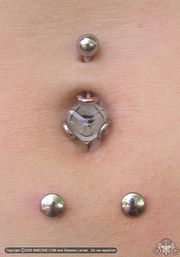Punch And Taper: Difference between revisions
(Created page with "<html><div class="mw-content-ltr" dir="ltr" id="mw-content-text" lang="en"><div class="thumb tright"><div class="thumbinner" style="width:182px;"><a class="image" href="/index.php?title=File:Punchandtaper.jpg"><img alt="" class="thumbimage" height="257" src="/images/thumb/a/a6/Punchandtaper.jpg/180px-Punchandtaper.jpg" width="180"/></a> <div class="thumbcaption"><div class="magnify"><a class="internal" href="/index.php?title=File:Punchandtaper.jpg" title="Enlarge"><img a...") |
(Page conversion via llm-mediawiki-rev -jwm) |
||
| Line 1: | Line 1: | ||
[[File:Punchandtaper.jpg|thumb|right|180px|Punch and taper surface piercing by [http://russfoxx.bmezine.com Russ Foxx]]] | |||
'''Punch and taper''' is a technique used for performing [[Surface piercings|surface piercings]]. | |||
Three piercers ([[Brian Decker]], [[Tom Brazda]] and [[Zachary Zito]]), generally credited with developing punch and taper surface piercing, noted the difficulty involved with attempting to use a regular piercing needle to create a piercing with 90-degree subcutaneous bends (though it is possible using an advanced technique involving two needles). They all came up with the idea of using a [[Dermal Punch]] to create the portions of the piercing perpendicular to the surface of the skin, and then using a [[Taper]] or [[Elevator]] to separate the dermis from the connective tissue below, making the path for the jewelry exactly the same shape as the jewelry itself. | |||
Clients have reported less procedural pain (although it does take longer than the needle method) and reduced healing times. However, this technique doesn't remove all the risks and problems with viability of surface piercings; surface piercings are still difficult to heal, and the placement needs to be chosen carefully. | |||
== External links == | |||
A fuller explanation of the history of this technique, including procedural photographs can be found in the [http://news.bmezine.com/2004/10/15/punch-and-taper-surface-piercing-the-publishers-ring BME article on Punch and Taper Surface Piercing]. | |||
Latest revision as of 10:15, 17 September 2023

Punch and taper is a technique used for performing surface piercings.
Three piercers (Brian Decker, Tom Brazda and Zachary Zito), generally credited with developing punch and taper surface piercing, noted the difficulty involved with attempting to use a regular piercing needle to create a piercing with 90-degree subcutaneous bends (though it is possible using an advanced technique involving two needles). They all came up with the idea of using a Dermal Punch to create the portions of the piercing perpendicular to the surface of the skin, and then using a Taper or Elevator to separate the dermis from the connective tissue below, making the path for the jewelry exactly the same shape as the jewelry itself.
Clients have reported less procedural pain (although it does take longer than the needle method) and reduced healing times. However, this technique doesn't remove all the risks and problems with viability of surface piercings; surface piercings are still difficult to heal, and the placement needs to be chosen carefully.
External links
A fuller explanation of the history of this technique, including procedural photographs can be found in the BME article on Punch and Taper Surface Piercing.